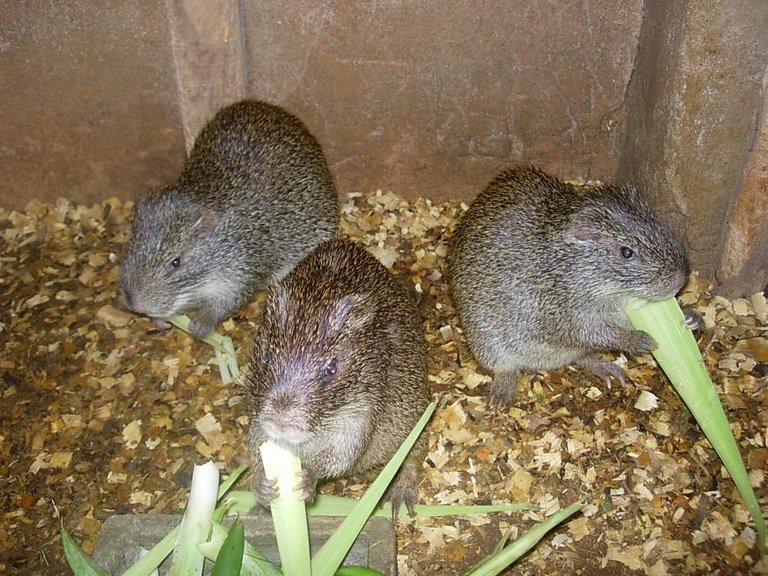
The art of reproducing grasscutters- otherwise known as rearing or raising or farming grasscutters is known as GRASSCUTTERY.
Actually, the animal is known as the cane rat or cutting grass which is known and called locally as OYA in Yoruba land,NCHI in Ibo land ,GEBGI in most part of Hausa land.
The Urhobo or isokos call it UDI, the Ijaws call it IKIRI and IZAY by the Igbirras,EVUATOR by the Binis, EMI in Igala land,UNAM-UKOT by the Afiks/Idibios
Outside Nigeria, the French call it AULACODE, and of course, CANE RAT/ CUTTING GRASS by the English. Grasscuttery falls within the category of mini or micro livestock farming.
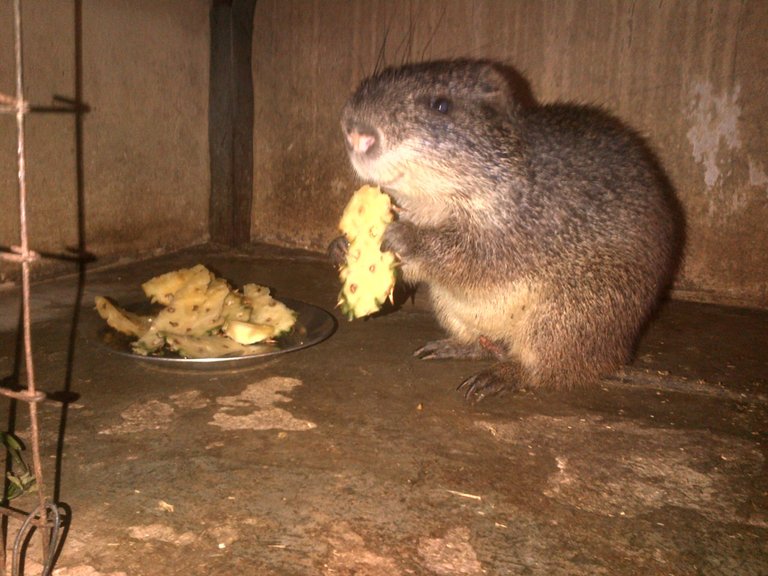
What is mini livestock farming?
Mini livestock farming deals with raising of small animals species derived from the wild life bank used as food, feeds , source of income, raw materials, research purposes, preservation of their existence, etc. in given pairs of the world. Some are purely tropical.
These include;
• The grasscutter ˃ the graint bush rat
• Rabbits (Hare) ˃ Bush fowls
• African grant snail ˃Edible maggots
• Housefly maggots ˃ Guinea pigs
• Geese ˃ Quails ˃ Honey Bees and SERPENT (Venomous Snakes)
This class of animal Species has not been included in the conventional training program of the animal production specialist, such as the animal scientist or the veterinary doctor or agriculturist in our various institutions of higher learning or agricultural institutions.
Consequently, the rearing has been officially or otherwise ignored by the livestock services of many countries such as Nigeria.
Nevertheless, in order to create awareness of the possibilities of re producing some of these species by domestication, some institution and individuals have taken the challenge to develop technologies of re-production especially the grasscutter.
CHALLENGES
LIMITED KNOWLEDGE
. The best structures required -Externally and Internally
• The nutritional requirement of the animals
• Identification of sickness and diseases and cures
• Lack of vaccinations
• Shortening of gestation period
• High breed identification issues
• Growth rate
PROBLEM OF ACCESSING FUNDS
. This is a serious challenge unlike poultry, piggery, fishery or crops, not so with grasscuttery.
• No financial institutions, agency etc are ready to give financial assistance either as loans or grants
• Efforts are being made to form grasscutter farmers co-operative societies or associations to ease assessing funds.
LACK AND COST OF GOOD PARENT STOCK
SHORTAGE OF FORAGES DURING DRY SEASON
HIGH INITIAL COST OF ESTABLISHING GRASSCUTTER FARM
BENEFITS OF GRASSSCUTTER FARMING
Nutritional value
Nutritionally, the grasscutter meet highly compares with many domesticated animal. The taste is wonderful, it is a lean meat with a crude protein of 22.7%.
Economic Benefits
The grasscutter could be reproduced for income/ revenue generation for its game meat, breeding stocks, feed producers, carpenters, transporters, researchers, exhibition/ shows and veterinary product dealers.
Employment
It is one of the ways of curbing the ugly scourge of unemployment.Africa has over 800 million people in population. Over 50% of these live in abject poverty below the $1 mark .Over 60% of this population are youths – energetic with ability , new innovations and technological competence to carry out commercial and technological agriculture.We must prevent our youths from being free radicals, social misfit and crime inventors due to unemployment pains. Grasscuttery, along with other agro enterprises will help.
It is greatly abnormal to find graduates roaming the streets searching for jobs that are not even there due to global economic down turn. Majority have turned out to be commercial okada (bike ) riders. Have you thought of heinous crimes committed that have become rampant- armed robbery, kidnapping, political thuggery, internet frauds, etc.
Grasscuttery has its quota to assist in unemployment solution
Production of certain pharmaceutical drugs
The blood, brains, organs especially (insulin ) from the pancreas are used for the production of medical products.
In some communities, the fur, when burnt and mixed with black pomade is an effective healing balm.
CULTURAL VALUE
FERTILIZER (WASTE PRODUCTS)
POTENTIAL
-test animals for medical drugs
-food seasoning
-source of hide and skin
-gift
-export market
-ornamentals
-fish feeds
CONSERVATION OF THE SPECIES AND THE ECO-SYSTEM
UNIQUE FEATURES
ACCEPTABILITY
ECONOMY OF LAND USE
LOW COST OF RUNNING AFTER ESTABLISHMENT
MARKET
ENVIRONMENTAL FRIENDLY
TECHNICALLY, LESS HEALTH PROBLEM
RETURN ON INVESTMENT
CONNECTIVITY
CAN EASILY MANAGED BY ALL


GENERAL CHARACTERISTICS
Classification
• Kingdom: Animalia
• Phylum: Chordata
• Class: Mammalia
• Order: Rodentia
• Sub order: Hystricomorpha
• Family: Thryonomyidae
• Genus: Thryoinomys
• Species: swinderianus, gregorianus
• Grasscutters are warm blooded animals
• The adult grasscutter measure about 72cm for the male and 67cm for the female including the tail and may weigh between 4 to 10kg.
• Grasscutters have simple stomach
• Grasscutters are herbivores. They cut and feed mainly on grasses and leaves. This is where the name grasscutter is drawn
• Grasscutters are not carnivorous. This means that, they do not eat themselves or other animals. However, they might fight and wound each other.
• Grasscutters have four (4) sharp and strong incisors teeth (2 up and 2 down). These sharp incisors are even present in day old.
• Grasscutters are viviparous, that is, they bring fort their young ones alive.
• The young grasscutters are precocial, that is, they are born fully haired with open eyes and are capable of following their mother immediately after birth.
• Grasscutters have mammary glands from which they secrete milk to feed the young ones
In Nigeria, there are two major species of grasscutters. The Northern specie known as Thryonomys gregorianus and the southern specie known as Thryonomys swinderianus. The Southern specie attains larger size compared to the Northern specie of the same age. The Southern specie can successfully grow in the North but the Northern specie finds it difficult to survive in the South.
GRASSCUTTER LIFE IN THE WILD NATURAL HABITAT/HABIT
• The natural habitat of grasscutters is grassland, secondary growth in rain forest areas, derived guinea savanna. They are also found in degraded forest, farm lands with weeds, oil palm plantation and sugar cane plantations. They are also found in swamps, marshes, borders of lakes and streams and rocks.
• Grasscutters do not burrow but can live in holes burrowed by other animals and rock crevices when in danger and during raining season.
• Grasscutters live mainly in areas where there is an annual rainfall of over 750mm which is common in areas with 7-8months of rainfall.
• The male grasscutter is like the man in the house. In starting a family, the male moves round to select 3-4 females. They move together as a group until they are ready to reproduce.
• The male takes care of all the females in the group by protecting them against danger, sourcing for where they will get food. This is why you always see the male in the front, when the group of grasscutters is moving without the colony, when you look very well you will found out that it is a male either going to source for where there forages to graze or checking if there is danger on the way or sourcing for females to constitute a family.
FEEDING IN THE WILD
In the wild grasscutters source for all their food
They are said to be pests because they feed on crops thus destroying them
They cut and feed on grasses like elephant grass, maize crops, rice, Guinea grass and guinea corn.
They also feed on other crops like young palm trees, cassava, yam etc.
They go out for feeding very early in the morning or late in the evening, when they know that the farmers have gone from the farm.
Because of this, they feed two times a day except on special occasion where the environment is absolutely quiet, they can feed three times.
PROBLEMS FACING GRASSCUTTERS IN THE WILD
In the Niger delta area and in Nigeria as a whole, grasscutters are hunted indiscriminately. Destructive harvesting is the order of the day. No concerted effort has been made to conserve this wild life species. The different ways which these animals are hunted include the following:
Traps: Hunters set traps in the bush along the paths which they noticed that these animals are passing and when these animals unknowingly pass through the trap, they are killed through the traps.
Guns: some other groups of hunters use dogs and guns to kill these animals.
Cages: Some other hunters use cages like the traps. When the animals run into the cages, they are trapped and killed. In using the cages most of the hunters put attractants in the cage, these attract the animals into the cage and they are killed.
Bush Burners: This group uses fire for hunting. When they noticed that grasscutters are living in a given area, they set fire in that area, so that the fire will chase out the grasscutters from their natural habitat while the hunters hang out around the bush waiting for any of the grasscutters to run out.
Poachers: This group of hunters goes into the forest reserves to hunt for animals. They kill animals against government regulations.
Diminishing natural habitats due to man activities.
Predators like giant snakes e.g. Python
With the above problems in existence in our society, the grasscutters will soon go into extinction if proper care and effort is not made to conserve or domesticate them.
FACTORS TO BE CONSIDERED IN ESTABLISHING A GRASSCUTTER FARM
. All the challenges outlined above
• Land availability and location
• The size of the farm and size of stock to be kept
• Adequate and suitable housing and equipment
• Source of initial stock
• System of production to be used
• Finance
• Management
• Staffing
• Nutrition and feeding
• Availability of market
MANAGEMENT
• EXTENSIVE SYSTEM
• SEMI-INTENSIVE SYSTEM
• INTENSIVE SYSTEM
EXTENSIVE /FREE RANGE SYSTEM

In this, animals are reared in an enclosure with good pastures or natural vegetations. An area of 12m2 can be provided for a family of one male and four to six females.
Maize, guinea corn, sugar cane, elephant grass, cassava, rice etc. are planted in such an area to provide a condition that is close to that of the wild. The area should be fenced with strong and durable materials like iron or bricks, to keep off predators and thieves
SEMI-INTENSIVE SYSTEM
This system is just like extensive system; the only difference is that shelters are provided at one part of the area. The animals run in to the shelter during rains. They may also sleep in the shelter. Bedding in the sleeping area should be changed regularly with dry grasses. Feeders and drinkers are placed in the shelter. Limited quantity of balanced feeds, grains, cut grasses etc. are usually provided
This method is uncommonly used.
INTENSIVE SYSTEM
This system is the most widely used. It involves a total enclosure with the animal being taken care of by the farmer .Abundant quantity of balanced feeds, grains as well as medications are provided in this system.it is the most cost efficient once set up.


Intensive: Deep Litter (Floor Hutches) System.

Intensive: Tier/Battery Brick Hutches
EQUIPMENT
The equipments required for keeping grasscutters are
1 Feeders and Drinkers 2 Trapping equipment
3 Transport boxes 4 Wheel barrow
5 First aid box 6 Weighing scale
7 Brushes and brooms 8 Waste scrappers
9 Mop 10 Buckets
11 Tanks and drums 12 Cutlasses
13 Spades/Hoe 14 Sprayers
15 Identification equipment 16 Polythene sheets
17 Coverall 18 Boots
19 Hand gloves
DAILY ACTIVITIES (ROUTINE OPERATIONS)
STEP 1:
• Observation/Inspection: As the attendant opens up the farm house in the morning or at any time, the golden rule is to “feet dip” in the dip pit at the entrance which must contain water mixed with strong disinfectant.
• Note: Any person seeking access to the animals must feet dip. Usually no foot wear should be allowed from outside. In any case, the farmer can provide special slippers that should only be used within the farm house.
• Conduct a check on all the animals, inspecting each pen to ascertain the state of health, completeness, amount of food eaten, their feaces, injuries, jump outs, mortality, deliveries etc.
• Any abnormal observations should be investigated and addressed immediately.
• Recordings made in the daily routine record book.
STEP 2: CLEANING
• All the pens, cages, hutches and farmhouse must be cleaned: all feaces, leftover forage or feeds and water cleared out.
• Water spillage and urine on the floor should be mobbed or spread ashes or dry white sand to absorb liquid and then sweep out.
• Drinkers must be well rinsed and feeder thoroughly brushed with either hard brush or a cut broom and then capsized against the wall to dry until next use.
• Weekly disinfecting should be done of entire house and equipment
STEP 3: FEEDING
The animals are fed 2-4 times a day, depending on the feeding schedule adopted, which should be adhered to as the animals will get accustom to these times and be expecting their food at such times.
Grasscutter is a monogastric animal. These are animals that depend on one particular type of food. All monogastric animals require 13 amino acids, 13 mineral elements, 13 vitamins, Lonoleic acid and water. Specifically, there is dearth of published information on the nutrients requirements of grasscutters. In BioDec, we use the following nutrient ratio which has been effective:
• Protein 18 ---------- 24%
• Energy 2300 ------- 2500Kcal
• Calcium 0.5 --------- 1%
• Phosphorous 0.3 ------- 0.5%
• Cellulose 8 ---------- 10%
These nutrients cannot be obtained from only grasses hence, there is feed supplement that will take care of the nutrients that cannot be obtained from grasses. Fruits and vegetables are given to the grasscutters to increase their resistance to diseases and optimum growth.
There are three major types of feed grouped as they are fed to the animals. These include:
• Fodder
• Compounded feed
• Fruits and Tubers
FODDER (GRASSES)

The major food for grasscutter is grasses or forage. There are different types of grasses that are used in the feeding of grasscutters, these include: Elephant grasses, Guinea grasses, Gamba grasses, Sugar cane, Maize, Rice, millet, Sorghum etc.

FORAGE (GRASSES)
• Elephant Grass (Pennisetum Purpureum)
• Guinea Grass (Panicum Maximum)
• Sugar Cane (Saccharum Off icnariom)
• Gambia Star Grass (Andropogan Gayanus)
• Maize Stalk (Zea Mays)
• Rice Stalk (Oryza Sativa)
• Millet Stalk
• Sorghum Stalk (Sorghum bicolour)
• Mevura of palm trees and coconum trees
• Pineapple crowns (leaves)
• Spear Grass (H.rufa)
It is advised that the farmer should plant his own fodder bank, to adequately provide disease free feed for the animals at all times
FORMULATED FEED
This is a supplementary feed added to grasses to make up for the nutrients that cannot be obtained from grasses. The formulated feed may be made into pellets or the mash can be banded with starch and made into crumbs before feeding.
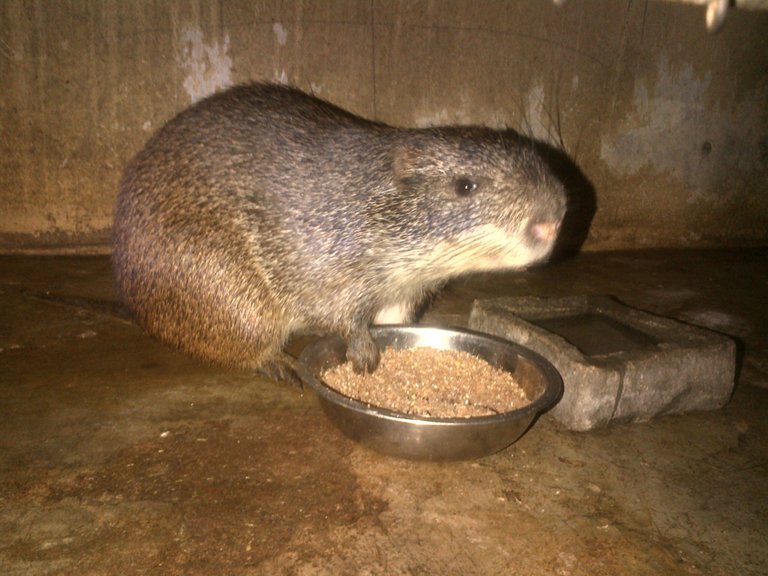
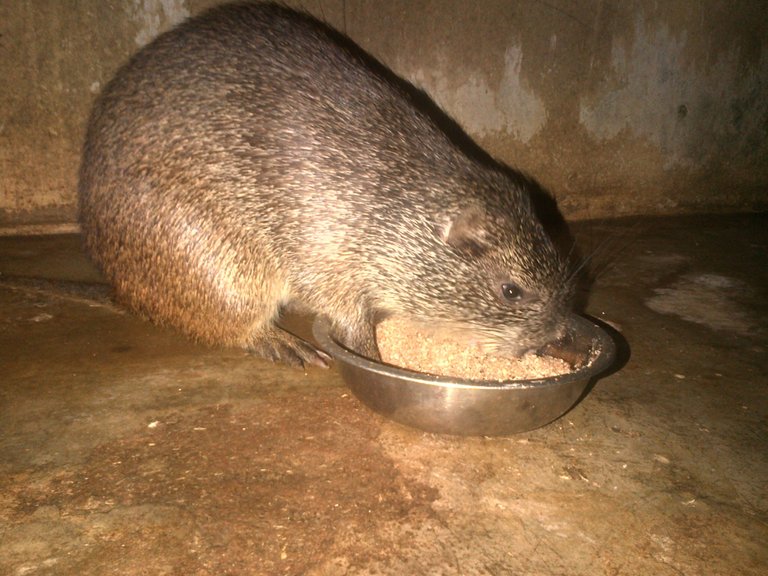
FRUITS AND TUBERS
This group of feed is also a supplement to take care of the raw energy required by the grasscutters to function. The fruits help to increase the immune system of the animal.
TUBERS: (i) Cassava (ii) Sweet/Irish Potatoes (iii) Yam (iv) Cocoyam
FRUITS: pineapples, pawpaw, mangoes, cashew, carrot, cucumber, lettuce, guava, etc.
LEAVES: Pumpkin, Pineapple crown, Cassava
SEEDS: Coconut, Soya beans (roasted), Beans (roasted), Groundnut
HOME FOOD – Bread and biscuits, after being cultured
FEEDING MANAGEMENT
The feeding of the grasscutters can be done in the following regime which ensures that they are fed ad libitum (this means there is food all the time). It should be noted that grasscutters do not withstand starvation for a long time:
• 1st Feeding: 7 ------- 9am ----------Fodder (grasses)
• 2nd Feeding 12------ 1pm---------- Formulated feed
• 3rd Feeding 3------- 4pm --------- Fruits and Tubers
The quantity of feed to be served depends on the period. In the dry season one stick of elephant grass of 1.5ft length will serve one grasscutter but during the raining season, one length of elephant grass of 3ft will be enough for one grasscutter. For the formulated feed 125g will serve one grasscutter for one day.
4 TIMES FEEDING CAN ALSO BE ADOPTED
1st Feeding 7am - 9am - Only Forage (grasses)
2nd Feeding 12pm - 1pm - Formulated rations
3rd Feeding 3pm - 4pm - Fruits and Tubers
4th Feeding 6pm - 7pm - Forage
NOTE:- At all feeding times, water should be served along with whatever that is given to the animals. The grasscutter is a wasteful eater. It is advisable to feed them in bits at a time.
NOTE:
The forage (grass constitute over 85% of their food)
The grasses should be cut and sun dry for at least 18 hour (preferably day break) before being served to the animals for fermentation and insect/lava to craw off. Where fresh forages are to be served, they should be soaked for some 10-20 mins in salt water to kill all micro-organisms, larve and eggs of infective insects.
The grasscutter prefers the succulent part of the stalk. The stalk should be “skinned”, cut into length of 20cm and sliced. A bunch of 30-40 sticks will serve 30 animals. These figures are to guide the commercial farmer who is advised to cultivate a food bank due to short fall in the dry season, when grasses dry up and incidences of bush burning are common that leads to scarcity of forages.
The grasses are placed slanting against the wall of the pens. The idea is for the animals to pull them one after the other down to avoid trampling upon or urinating on them. Once they do this, they will not eat such grasses again.
Maize, sorghum, millet stalks could be substituted for the grasses during their seasons. Where there is an integrated farming system where these cereals are grown all year round, this will be a good added advantage. These stalks can be served immediately.
New fresh stems and leaves are better for the young ones (cuttlings). The older and harder stalk should be splitted.
The forage should be washed with saline water, especially where they are gotten from places outside the farm site or fodder bank. This is to prevent infections of parasites, worms, etc.
The grasses should be alternated for the animals to get various nutrients and vitamins
REPRODUCTION AND BREEDING
BASIC TERMINOLOGY
Male – buck
Female – Doe
Young – Cuttling
Breeding Age: This is the period in which the grasscutters are said to be sexually matured. It is otherwise known as age of puberty. It is said to be a critical period because it marks the beginning of the grasscutters reproductive life. The breeding age is usually 5months. The doe at this age will weigh 1.5 to 2kg while the buck will weigh 2 to 2.5kg.
Gestation Period: This also known as the pregnancy period. This period is between conception and birth. The gestation period in grasscutters is 145 to 167 days which reduces with successive pregnancies.
Breeding Ratio: The breeding ratio in grasscutters ranges from 1 Buck: 3 to 6 Does. Generally the ratio of 1 buck: 4does is constituted to make a family. This is to avoid over using of buck. A ratio of 1buck to 1 doe is not safe as it encourages fighting and conception has been observed to be absent.
Parturition: This is the process of the doe giving birth to cutlings.
Birth Interval: This is the period between one parturition and the other. The birth interval is between 6 -11months. The management, state of animals etc. is influencing factors that affect the birth interval.
Heat: Heat period is the period in which the doe is ready to accept the buck and pregnancy can take place. In grasscutters there is no definite oestrus period but it occurs though in a very short form. This is one of the reasons why the buck is housed together with the does.
Research has shown that when grasscutters are on heat, the following signs can be observed:
• Restlessness
• Nervousness
• The fur becomes more glossy and shiny than normal
• Discharge of mucus from the vulva that is slightly swollen
• Making of whistling sound
• The doe sniffs or smells the buck and even attempt to ride it.
Litter Size: This is the number of cutlings each doe can give birth at a time. In grasscutter farming the litter size is between 1 and 11 with an average of 4 cutlings, depending on your management. T. grigorianus averages 3-5 cutlings while T. swinderianus averages 3-4 cutlings.
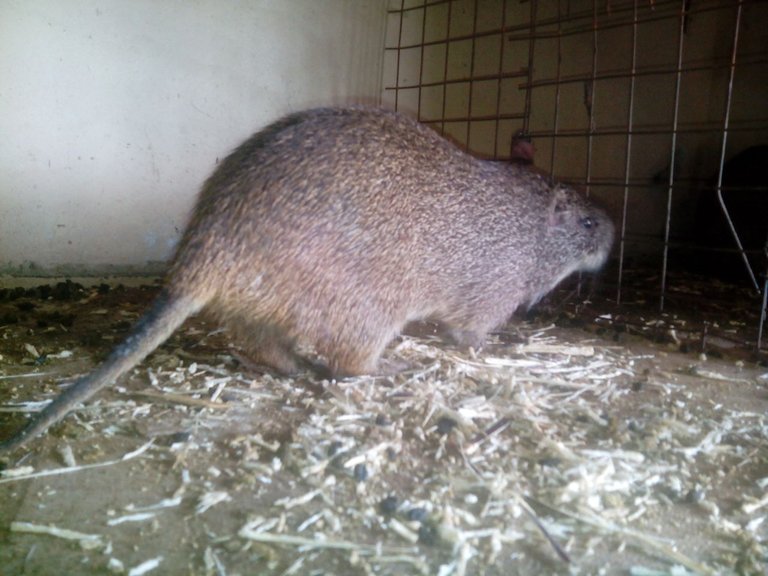
Male (Buck)
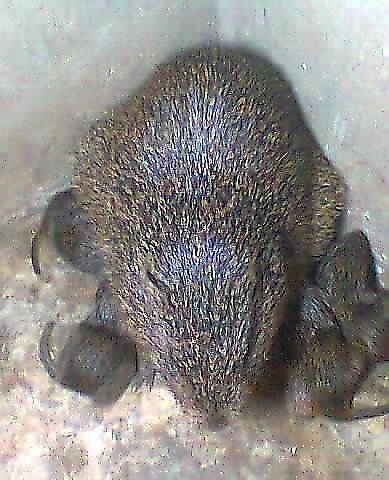
Mother Doe and Suckling Cutlings.
MARKETING FOR GRASSCUTTER
Africa in general and Nigeria in particular, there is a big market for grasscutters. Grasscutter meat is generally referred to as meat for ‘big men’. Grasscutter meat is delicious and is regarded as a delicacy. It is highly cherished. The nutritive value of grasscutter is relatively high. The crude protein content is about 22.7% and hence it can help to meet the protein shortage in the country.
This is the reason why every body wants to eat grasscutter meat. Most of the national and international hotels want to incorporate grasscutter in their menu but the problem is the regular availability of grasscutter meat.
The availability of market for grasscutter can not be overemphasized because we need to meet up with the demands from these hotels and individuals since we can not depend on the wild colony to meet this demand.
The intending breeders need to get their start up stock and we can not go to the wild where the animal is almost going into extinction to get a start up stock. This means that the demand for grasscutter is increasing per day as a lot of people are getting the awareness.

Younger me carrying a doe at the commencement of this project.
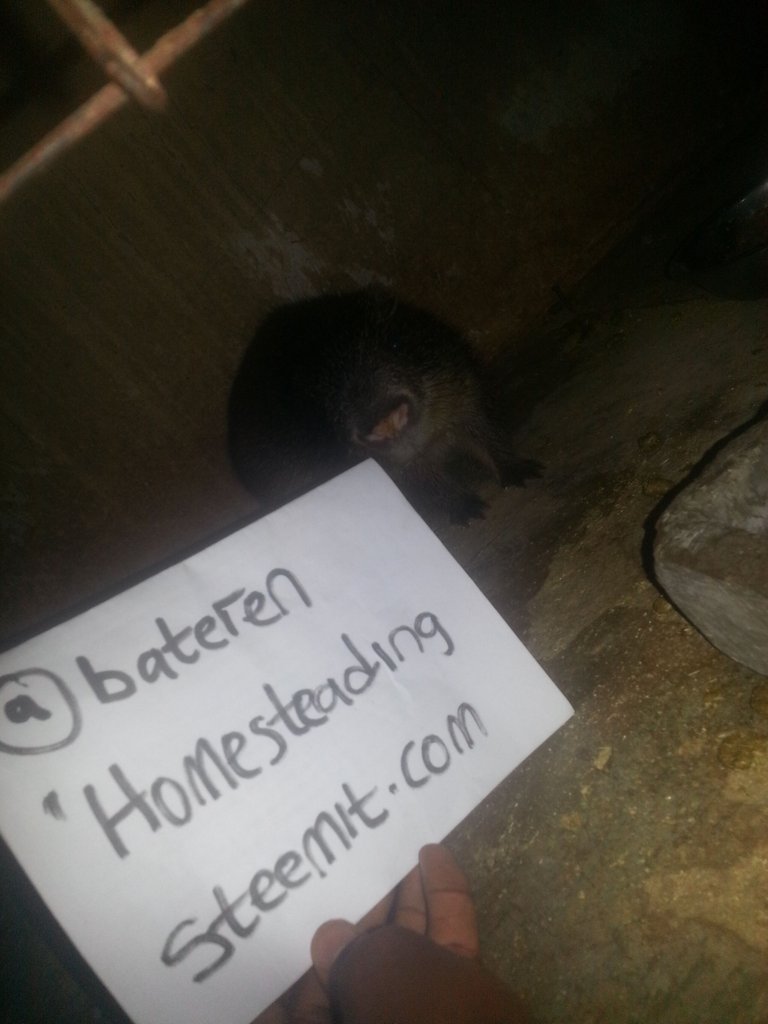
Grasscutter rearing is becoming widely popular in Nigeria thus making it a booming venture to go into.
Thanks for dropping by,please upvote and drop comments.
P.S: ALL PICTURES WERE TAKEN BY ME WITH MY DIGITAL CAMERA AND SAMSUNG MOBILE PHONE
Come Join Us!!! Newbie Resteem Initiative
and join the Steemit Newbie Resteem Initiative Discord channel here: https://discord.gg/xcekaZU
You have been resteemed as part of #newbieresteemday. Congratulations on your content Newbie and as always, Keep Steemin’! I invite you to learn more about the initiative andThanks for dropping by,i appreciate the upvote and the resteem @amariespeaks.
you're welcome!
Wow!
This is post is long! And Educational!
Thanks boss... I appreciate to a great extent
This very educational. My side attraction was you as child holding the grasscutter. Weldone sir.
Thank you boss, i am deeply honored. We ahve to go back to our roots o
what a wonderful work... quality post
...show this to @curie
Thank you boss.... I appreciate, thanks for dropping by!
Extremely informative article. This is nice
Thanks a lot. Its highly appreciated
Nice one. Totally educational
Hailings brother.. I dormor you
Bro this is indeed very awesome!! Enlightening and interesting stuff and I absolutely do love it! Nice one.
They make excellent meat, that is why they are always hunted. You can't blame man for their love for grasscutters
Great post and very educational.